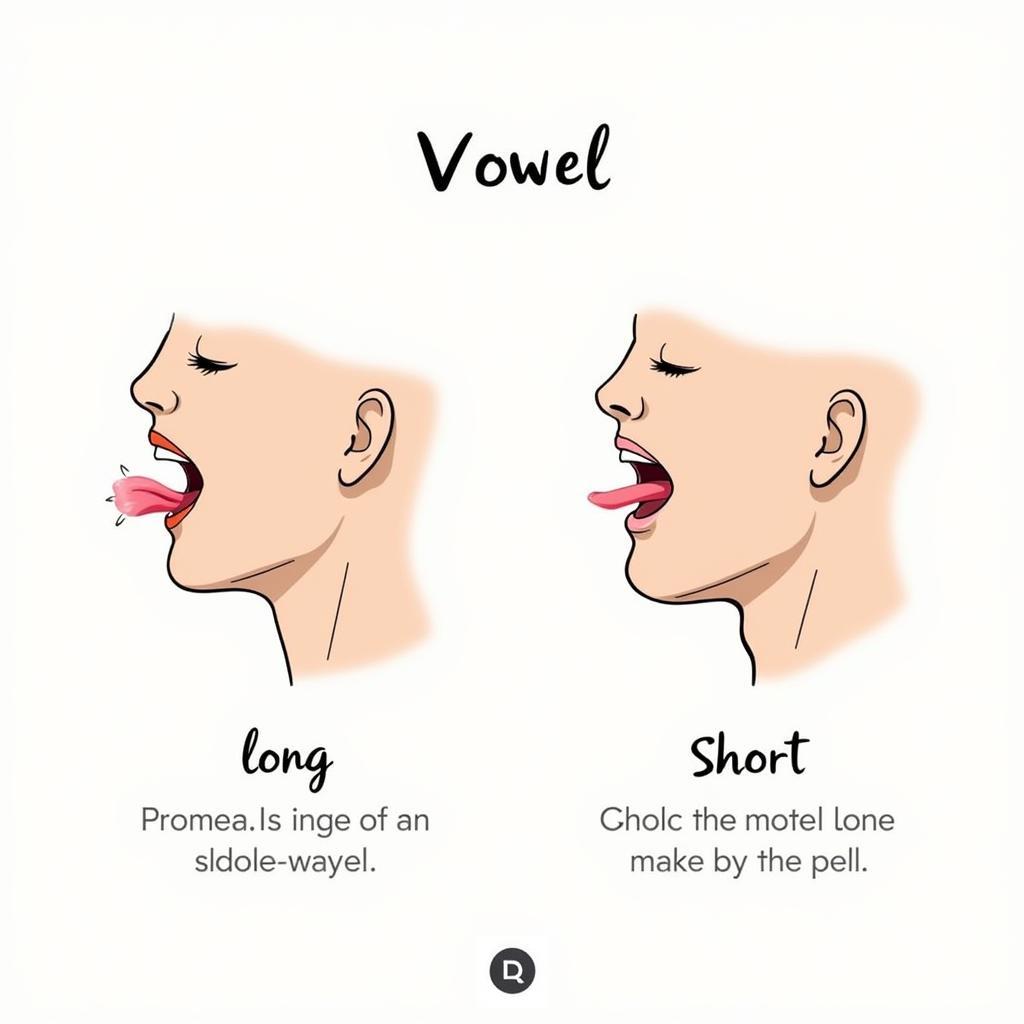Understanding the difference between long and short vowels is crucial for anyone learning or teaching English. This distinction impacts pronunciation, spelling, and overall comprehension. This guide will delve into the intricacies of Long Vs Short Vowels, providing clear explanations, practical examples, and helpful tips to enhance your English language skills.
Decoding the Mystery of Long and Short Vowels
Vowels are the heart of any spoken language, and English is no exception. While there are only five vowel letters (a, e, i, o, u), they produce a variety of sounds. The key difference between long and short vowels lies in their duration and how they resonate in the mouth. Long vowels sound as if you are saying the name of the letter itself. For example, the ‘a’ in “cake” sounds like you are saying the letter ‘a’. Short vowels, on the other hand, have a quicker, more clipped sound, as in the ‘a’ in “cat”.
 Distinguishing Long and Short Vowels
Distinguishing Long and Short Vowels
Identifying Long Vowels: Hear the Name, Say the Name
Long vowels are generally pronounced as the name of the letter suggests. Think of the ‘e’ in “me,” the ‘i’ in “bike,” the ‘o’ in “go,” and the ‘u’ in “mule.” A common way to identify long vowels in written words is by looking for vowel combinations. For instance, two vowels together often indicate a long vowel sound, like the ‘ea’ in “bead” or the ‘ai’ in “rain”. Another clue is a silent ‘e’ at the end of a word, as in “cake” or “kite.” These silent ‘e’s often signal that the preceding vowel is long.
Short Vowels: Quick and Concise
Short vowels are typically crisp and brief. Consider the ‘a’ in “apple,” the ‘e’ in “bed,” the ‘i’ in “sit,” the ‘o’ in “hot,” and the ‘u’ in “cut.” These sounds are shorter in duration compared to their long vowel counterparts. Recognizing short vowels often involves understanding common spelling patterns. Single vowels in a closed syllable (a syllable ending in a consonant) usually indicate a short vowel sound.
Why Differentiating Long vs Short Vowels Matters
The distinction between long and short vowels is paramount for correct pronunciation and spelling. Mispronouncing vowels can lead to communication breakdowns, while misspelling them can hinder written communication. Mastering this crucial element of English pronunciation significantly enhances clarity and fluency. Furthermore, understanding vowel sounds lays a solid foundation for reading comprehension and vocabulary acquisition.
How Can I Practice Differentiating Between Long and Short Vowels?
Practice makes perfect! Listen to native English speakers, pay close attention to their vowel pronunciation, and try to mimic them. Record yourself speaking and listen back to identify areas for improvement. Use online resources, language learning apps, and pronunciation dictionaries to familiarize yourself with the nuances of long and short vowels.
Long vs Short Vowels: A Quick Recap
To solidify your understanding, here’s a concise summary of the key differences between long and short vowels: Long vowels say their name, while short vowels have a shorter, clipped sound. Long vowels are often indicated by vowel combinations or a silent ‘e’ at the end of a word, whereas short vowels typically appear in closed syllables.
Conclusion: Unlock the Power of Vowels
Mastering the distinction between long and short vowels is a fundamental step towards achieving fluency and accuracy in English. By understanding the rules and practicing regularly, you can significantly improve your pronunciation, spelling, and overall communication skills. This knowledge will empower you to confidently navigate the complexities of the English language and unlock its full potential. Now that you’ve learned about long vs short vowels, practice applying these principles to your everyday English usage.
FAQ
-
What are the five main vowel letters in English?
- The five main vowel letters are a, e, i, o, and u.
-
What is the easiest way to remember the difference between long and short vowels?
- Remember that long vowels say their name, while short vowels have a quicker, clipped sound.
-
Why is it important to learn about long and short vowels?
- Understanding long and short vowels is crucial for correct pronunciation, spelling, and overall comprehension.
-
What are some common spelling patterns for short vowels?
- Short vowels typically appear in closed syllables (syllables ending in a consonant).
-
How can I improve my pronunciation of long and short vowels?
- Listen to native speakers, practice regularly, and use online resources to enhance your pronunciation skills.
-
What are some examples of words with long vowel sounds?
- Cake, me, bike, go, mule.
-
What are some examples of words with short vowel sounds?
- Cat, bed, sit, hot, cut.
Mô tả các tình huống thường gặp câu hỏi.
Người học tiếng Anh thường gặp khó khăn trong việc phân biệt và phát âm chính xác nguyên âm dài và ngắn, dẫn đến hiểu nhầm trong giao tiếp. Việc nắm vững kiến thức này cũng rất quan trọng trong việc học phát âm, đọc và viết tiếng Anh.
Gợi ý các câu hỏi khác, bài viết khác có trong web.
- Nguyên âm là gì?
- Phụ âm là gì?
- Cách phát âm các nguyên âm trong tiếng Anh.
- Cách phân biệt các nguyên âm trong tiếng Anh.